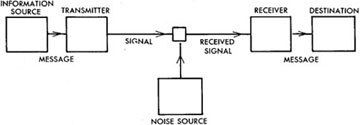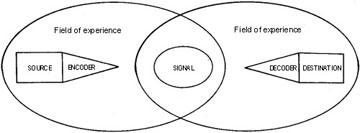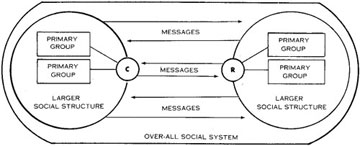Most Americans probably do not appreciate the importance of communication in their personal and workday lives. Hopefully, those of us in extension work recognize the importance of good, effective communications.
It's been estimated that many Americans spend 70 to 80 percent of their time in communication — writing, reading, talking, listening. This is certainly true of extension faculty. This suggests that communication may well be the key to success for an extension worker.
It seems that almost everyone talks about the need for communication — good, effective communication. University faculty often complain of poor communication between administrators and the faculty; students complain about lack of communication between the faculty and themselves. Parents bemoan the lack of communication between themselves and their children. Young people voice the same thought although from a different viewpoint. Farmers say the farm story needs to be told. Labor union members feel they aren't understood. And, ironic as it may seem, public relations experts fret over the feeling that the public misunderstands the objectives of their profession.
What is communication?
What is communication? It's an interesting exercise to ask members of a group to write, in a short paragraph, their meanings for the term. Two things become apparent: most individuals have difficulty writing out their actual meaning for the term communication, and there is a great variation in meanings.
We can look up the origin of the word. Communication comes from the Latin communis, "common." When we communicate, we are trying to establish a "commonness" with someone. That is, we are trying to share information, an idea or an attitude.
Looking further, you can find this type of definition: "Communications is the mechanism through which human relations exist and develop." This broad definition, found in a book written by a sociologist, takes in about everything.
In contrast, some people limit their definitions of communication rather narrowly, saying "communication is the process whereby one person tells another something through the written or spoken word." This definition, from a book written by a journalist, seems reasonable for those in that field.
Some definitions fall in between these two extremes. Carl Hovland, a well-known psychologist of a few years ago, said communication is "the process by which an individual (the communicator) transmits stimuli (usually verbal symbols) to modify the behavior of the other individuals (communicates)."
This definition describes what many extension workers hope to achieve. You'll be trying to change behavior.
Some object to this definition. Their objections center on the phrase "modify the behavior." They say there are numerous occasions when they communicate, in their family and social lives for example, with no intention of attempting to modify behavior. But, we most likely do modify others' behavior even though that may not be our intention.
We could find many other definitions of communication. However, "meanings are in people and not words" and it's not likely that we could get a group of any size to agree exactly on one meaning. Besides, an exact definition of the word isn't necessary. My goal is to illustrate that it's difficult for many to formulate their own definition and that there is a wide range in meanings.
The communication process
To communicate effectively, we need to be familiar with the factors involved in the communication process. If we are aware of them, these factors will help us plan, analyze situations, solve problems, and in general do better in our work no matter what our job might be.
This leads to a discussion of the communication process. Let's look at it part by part as viewed by several communication theorists. Communication is a concern to many people. So a lot of thought, work and discussion has gone into different communication situations. Today, such people as psychologists, educators, medical doctors, sociologists, engineers and journalists represent only a few of the professional groups whose members have developed ways of looking at and talking about the communication process in their specialized fields.
Several theorists have discussed the communication process in ways that have important implications for those involved in informal education programs such as extension work. Each of the "models" that we review has a point of vital interest.
Communication models come in a variety of forms, ranging from catchy summations to diagrams to mathematical formulas. One model of the communication process reviewed is also one of the oldest.
Aristotle's model
Aristotle, writing 300 years before the birth of Christ, provided an explanation of oral communication that is still worthy of attention. He called the study of communication "rhetoric" and spoke of three elements within the process. He provided us with this insight:
Rhetoric falls into three divisions, determined by the three classes of listeners to speeches. For of the three elements in speech-making — speaker, subject, and person addressed — it is the last one, the hearer, that determines the speech's end and object.1
Here, Aristotle speaks of a communication process composed of a speaker, a message and a listener. Note, he points out that the person at the end of the communication process holds the key to whether or not communication takes place.
Our failure to recognize what Aristotle grasped thousands of years ago is a primary cause, if not the primary one, for communication failure. We fail to recognize the importance of the audience at the end of the communication chain.
We tend to be more concerned about ourselves as the communications source, about our message, and even the channel we are going to use. Too often, the listener, viewer, reader fails to get any consideration at all.
Aristotle's words underscore the long interest in communication. They also indicate that man has had a good grasp of what is involved in communication for a long while. So we might even wonder: If we know so much about the communication process, and if we've known it for so long, why do we still have communications problems?
It's unlikely we will ever achieve perfect communication. The best we can hope for is to provide improved communication. Hopefully, we'll be more aware of the process and work harder to minimize problems with communications.
Lasswell's model
Harold Lasswell, a political scientist, developed a much quoted formulation of the main elements of communication: "Who says what in which channel to whom with what effect."2 This summation of the communications process has been widely quoted since the 1940s.
The point in Lasswell's comment is that there must be an "effect" if communication takes place. If we have communicated, we've "motivated" or produced an effect.
It's also interesting to note that Lasswell's version of the communication process mentions four parts — who, what, channel, whom. Three of the four parallel parts are mentioned by Aristotle — speaker (who), subject (what), person addressed (whom). Only channel has been added. Most modern-day theorists discuss the four parts of the communication process, but use different terms to designate them.
The Shannon and Weaver model
 Figure 1
Figure 1
Shannon and Weaver model.
Back in 1949 Claude Shannon, an electrical engineer with Bell Telephone, and Warren Weaver, of the Rockefeller Foundation, (Figure 1) published their book, The Mathematical Theory of Communication 3.
Shannon and Weaver attempted to do two things:
- Reduce the communication process to a set of mathematical formulas
- Discuss problems that could be handled with the model.
Shannon and Weaver were not particularly interested in the sociological or psychological aspects of communication. Instead, they wanted to devise a communications system with as close to 100% efficiency as possible.
You'll note that the Shannon and Weaver diagram has essentially the same parts as the one formulated by Aristotle. It's true the parts have different names, and a fourth component — in this case the transmitter — is included.
However, this model has an interesting additional element. Shannon and Weaver were concerned with noise in the communications process. Noise, Weaver said, "may be distortions of sound (in telephony, for example) or static (in radio), or distortions in shape or shading of picture (television), or errors in transmission (telegraph or facsimile), etc."
The "noise" concept introduced by Shannon and Weaver can be used to illustrate "semantic noise" that interferes with communication. Semantic noise is the problem connected with differences in meaning that people assign to words, to voice inflections in speech, to gestures and expressions and to other similar "noise" in writing.
Semantic noise is a more serious problem or barrier to developing effective communications than most realize. It is hard to detect that semantic noise has interfered with communication. Too often the person sending a message chooses to use words and phrases that have a certain meaning to him or her. However, they may have an altogether different meaning to individuals receiving the message. In the interest of good communication, we need to work to hold semantic noise to the lowest level possible.
We should be aware that there is a semantic noise in face-to-face verbal communication just as there is static noise, for example, in radio communication.
There are other kinds of noises involved in communication as well. Keep the noise concept in mind.
Schramm's model
 Figure 2
Figure 2
Schramm's model.
Wilbur Schramm, a well-known communications theorist, developed a straightforward communications model (Figure 2) in his book The Process and Effects of Mass Communications4.
In Schramm's model he notes, as did Aristotle, that communication always requires three elements — the source, the message and the destination. Ideally, the source encodes a message and transmits it to its destination via some channel, where the message is received and decoded.
However, taking the sociological aspects involved in communication into consideration, Schramm points out that for understanding to take place between the source and the destination, they must have something in common.
If the source's and destination's fields of experience overlap, communication can take place
If there is no overlap, or only a small area in common, communication is difficult. if not impossible.
For many years cooperative extension service agents [now known as extension faculty] developed considerable skill in communicating with the large American middle class. That success is understandable. A large number of extension workers came from this middle class, and there was a large overlap between the extension communicator and the middle-class audience.
However, in the 1960s, a period of growing social awareness, many extension workers were challenged — even mandated — to work with under-represented and diverse audiences. Many of the middle-class extension workers found it difficult to communicate with diverse audiences.
Extension tried to address this communications challenge by employing individuals from the target audiences, training them, and entrusting them to provide the important communications linkage. They were given such titles as leader aides, nutrition assistants, paraprofessionals and other like names.
The Rileys' model
 Figure 3
Figure 3
The Rileys' model,
John W. and Matilda White Riley, a husband and wife team of sociologists, point out the importance of the sociological view in communication in another way. The two sociologists say such a view would fit together the many messages and individual reactions to them within an integrated social structure and process. The Rileys developed a model (Figure 3) to illustrate these sociological implications in communication.5
The model indicates the communicator (C) emerges as part of a larger pattern, sending messages in accordance with the expectations and actions of other persons and groups within the same social structure. This also is true of the receiver (R) in the communications process.
In addition, both the communicator and receiver are part of an overall social system. Within such an all-embracing system, the communication process is seen as a part of a larger social process, both affecting it and being in turn affected by it. The model clearly illustrates that communication is a two-way proposition.
The important point the Rileys' model makes for us is that we send messages as members of certain primary groups and that our receivers receive our messages as members of primary groups. As you likely can visualize, group references may be a positive reinforcement of our messages; at other times they may create a negative force.
Berlo's model
The final communications model that we will consider is the SMCR model, developed by David K. Berlo, a communications theorist and consultant. In his book The Process of Communication,6 Berlo points out the importance of the psychological view in his communications model. The four parts of Berlo's SMCR model are — no surprises here — source, message, channel, receiver.
The first part of this communication model is the source. All communication must come from some source. The source might be one person, a group of people, or a company, organization, or institutions such as MU.
Several things determine how a source will operate in the communication process. They include the source's communication skills — abilities to think, write, draw, speak. They also include attitudes toward audience, the subject matter, yourself, or toward any other factor pertinent to the situation. Knowledge of the subject, the audience, the situation and other background also influences the way the source operates. So will social background, education, friends, salary, culture — all sometimes called the sociocultural context in which the source lives.
Message has to do with the package to be sent by the source. The code or language must be chosen. In general, we think of code in terms of the natural languages — English, Spanish, German, Chinese and others. Sometimes we use other languages — music, art, gestures. In all cases, look at the code in terms of ease or difficulty for audience understanding.
Within the message, select content and organize it to meet acceptable treatment for the given audience or specific channel. If the source makes a poor choice, the message will likely fail.
Channel can be thought of as a sense — smelling, tasting, feeling, hearing, seeing. Sometimes it is preferable to think of the channel as the method over which the message will be transmitted: telegraph, newspaper, radio, letter, poster or other media.
Kind and number of channels to use may depend largely on purpose. In general, the more you can use and the more you tailor your message to the people "receiving" each channel, the more effective your message.
Receiver becomes the final link in the communication process. The receiver is the person or persons who make up the audience of your message. All of the factors that determine how a source will operate apply to the receiver. Think of communication skills in terms of how well a receiver can hear, read, or use his or her other senses. Attitudes relate to how a receiver thinks of the source, of himself or herself, of the message, and so on. The receiver may have more or less knowledge than the source. Sociocultural context could be different in many ways from that of the source, but social background, education, friends, salary, culture would still be involved. Each will affect the receiver's understanding of the message.
Messages sometimes fail to accomplish their purpose for many reasons. Frequently the source is unaware of receivers and how they view things. Certain channels may not be as effective under certain circumstances. Treatment of a message may not fit a certain channel. Or some receivers simply may not be aware of, interested in, or capable of using certain available messages.
Summary
Here is a summary of the important thoughts illustrated by each model:
Aristotle: The receiver holds the key to success.
Lasswell: An effect must be achieved if communication takes place.
Shannon and Weaver: Semantic noise can be a major communication barrier.
Schramm: Overlapping experiences makes it easier to communicate successfully.
The Rileys: Membership in primary groups affects how messages are sent and received.
Berlo: Several important factors must be considered relating to source, message, channel, receiver.
These are just a few of the many views of the communication process that have been developed. There are many other communication theorists — McLuhan, MacLean, Westley, Stephenson, Gerbner, Rothstein, Osgood, Johnson, Cherry and others. Those briefly described here are pertinent to many everyday communication situations.
For an ending thought, let's return again to the idea that successful communication depends upon the receiver. As a communications source, we can spend a lot of time preparing messages and in selecting channels, but if the receiver doesn't get the message, we haven't communicated.
It's as Aristotle said: "For of the three elements in speech-making — speaker, subject, and person addressed — it is the last one, the hearer, that determines the speech's end and object."
References
- W. Rhys Roberts, "Rhetorica," The Works of Aristotle, volume XI, editor, W. D. Ross (London: Oxford University Press, 1924) p. 1358.
- Harold D. Lasswell., "The Structure and Function of Communication in Society," The Communication of Ideas, editor, Lyman Bryson (New York: Institute for Religious and Social Studies, Jewish Theological Seminary of America, 1948) p. 37.
- Claude F. Shannon and Warren Weaver, The Mathematical Theory of Communication, (Urbana, Ill.: The University of Illinois Press, 1964) p. 7.
- Wilbur Schramm, "How Communication Works," The Process and Effects of Mass Communication, editor, Wilbur Schramm (Urbana, Ill.: The University of Illinois Press, 1961) pp. 5-6.
- John W. Riley. Jr., and Matilda White Riley, "Mass Communication and the Social System." Sociology Today, Volume II, Robert K. Merton, Leonard Brown and Leonard D. Cottrell, Jr., editors. (New York: Harper and Row, 1965) pp. 537-578.
- David K. Berlo, The Process of Communication, (New York: Holt, Rinehart and Winston, Inc., 1960).
Material in this paper is drawn primarily from a chapter in the author's doctoral dissertation: Lee, Richard L. "The Flow of Information to Disadvantaged Farmers." Unpublished Ph.D. dissertation, University of Iowa, 1967. However, the author has drawn from several sources. Contents also are used in an expanded oral presentation prepared primarily for extension workers and adapted for other groups.